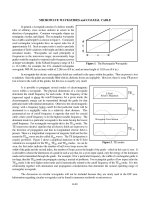Tài liệu Spanning-Tree - Root and Port Priorities pptx
Bạn đang xem bản rút gọn của tài liệu. Xem và tải ngay bản đầy đủ của tài liệu tại đây (22.86 KB, 5 trang )
Lab 5.2.5.2: Spanning-Tree - Root and Port Priorities
DLSwitch1
4006
10.1.1.250/24
ALSwitch
2900XL
10.1.1.251/24
Port 2/3 Port 1
Port 2/34 Port 12
Desired Root Bridge
Desired Active Uplink
Objective:
Modify the default behavior of spanning-tree by using root bridge and port priorities.
Scenario:
You are not happy with the way spanning-tree is working. Your access layer switch has become
your root spanning-tree switch, and you would like your distribution layer switch to serve this
function. You also want to use port priorities to control which links are elected as the active links.
In this lab, you will learn to control the operation of spanning-tree through priorities.
Lab Tasks:
1. Use the same configuration from the previous lab - 5.2.5.1 (Spanning-Tree Default Behavior).
Make sure your uplink cables are connected as shown in the graphic above.
2. Look at the spanning-tree output:
DLSwitch1> (enable) sh spantree
VLAN 1
Spanning tree enabled
Spanning tree type ieee
Designated Root 00-02-4b-21-36-c0
Designated Root Priority 49152
Designated Root Cost 3019
Designated Root Port 2/3
Root Max Age 20 sec Hello Time 2 sec Forward Delay 15 sec
Bridge ID MAC ADDR 00-02-4b-59-40-00
Bridge ID Priority 49152
Bridge Max Age 20 sec Hello Time 2 sec Forward Delay 15 sec
Port Vlan Port-State Cost Priority Portfast Channel_id
2/3 1 forwarding 3019 32 disabled 0
(Other output deleted)
2/34 1 blocking 3019 32 disabled 0
ALSwitch>sh spanning-tree
Spanning tree 1 is executing the IEEE compatible Spanning Tree protocol
Bridge Identifier has priority 49152, address 0002.4b21.36c0
Configured hello time 2, max age 20, forward delay 15
We are the root of the spanning tree
Topology change flag not set, detected flag not set, changes 5
Times: hold 1, topology change 35, notification 2
hello 2, max age 20, forward delay 15
Timers: hello 0, topology change 0, notification 0
Fast uplink switchover is enabled
Interface Fa0/1 (port 13) in Spanning tree 1 is FORWARDING
Port path cost 3019, Port priority 128
Designated root has priority 49152, address 0002.4b21.36c0
Designated bridge has priority 49152, address 0002.4b21.36c0
Designated port is 13, path cost 0
Timers: message age 0, forward delay 0, hold 0
BPDU: sent 2089, received 45
Interface Fa0/12 (port 25) in Spanning tree 1 is FORWARDING
Port path cost 3019, Port priority 128
Designated root has priority 49152, address 0002.4b21.36c0
Designated bridge has priority 49152, address 0002.4b21.36c0
Designated port is 25, path cost 0
Timers: message age 0, forward delay 0, hold 0
BPDU: sent 3222, received 42
Currently the ALSwitch (2900) is our root bridge and the active link between the two switch is
the link running from port 2/3 to port 1.
Modify this behavior so that the DLSwitch1 (4000) becomes the root bridge and the link from
port 2/34 to port 12 becomes the active link between the two switches.
3. Setting the root bridge priority:
Remember that the root bridge priority is determined by selecting the switch with the lower
BID (Bridge ID). The BID consists of the root bridge priority and the MAC address assigned
to that switch. The root bridge priority has a default setting of 49152. The current root bridge
is the ALSwitch because it has a BID of 49152-0002.4b21.36c0. This is not a real number.
The root bridge priority is expressed in decimal and the MAC address is expressed in HEX. It
would be a very large number if we had to convert the MAC address to decimal.
The root bridge priority is at the beginning of the BID. The bridge priority is also a very large
number. It will always be the root bridge priority that determines the length of the BID
because the MAC address is a fixed length. Therefore, if we set a bridge priority of 1 on the
DLSwitch1 and a bridge priority of 100 on the ALSwitch, the DLSwitch1 will always have the
smaller BID regardless of the MAC address.
Set the bridge priority to 1 on DLSwitch1:
DLSwitch1> (enable) set spantree priority 1
Spantree 1 bridge priority set to 1.
Immediately after issuing the above command, check to see who is the root of the spanning-
tree now:
DLSwitch1> (enable) sh spantree
VLAN 1
Spanning tree enabled
Spanning tree type ieee
Designated Root 00-02-4b-59-40-00
Designated Root Priority 1
Designated Root Cost 0
Designated Root Port 1/0
Root Max Age 20 sec Hello Time 2 sec Forward Delay 15 sec
Bridge ID MAC ADDR 00-02-4b-59-40-00
Bridge ID Priority 1
Bridge Max Age 20 sec Hello Time 2 sec Forward Delay 15 sec
You can see that the root priority is now set to 1, and that the designated root’s MAC address
matches the bridge ID MAC address (listed further down in the output). This means that we
are now the root bridge.
Just to make sure, examine things on ALSwitch:
ALSwitch#sh spanning-tree
Spanning tree 1 is executing the IEEE compatible Spanning Tree
protocol
Bridge Identifier has priority 49152, address 0002.4b21.36c0
Configured hello time 2, max age 20, forward delay 15
Current root has priority 1, address 0002.4b59.4000
Root port is 25, cost of root path is 3019
Topology change flag not set, detected flag not set, changes 3
Times: hold 1, topology change 35, notification 2
hello 2, max age 20, forward delay 15
Timers: hello 0, topology change 0, notification 0
Fast uplink switchover is enabled
Notice that it no longer tells us that we are the root bridge. It does give the MAC address and
priority of the current root bridge.
Set the bridge priority to 100 on ALSwitch:
ALSwitch(config)#spanning-tree priority 100
Check again with the show spanning-tree command to make sure the priority has
changed:
ALSwitch#sh spanning-tree
Spanning tree 1 is executing the IEEE compatible Spanning Tree
protocol
Bridge Identifier has priority 100, address 0002.4b21.36c0
Configured hello time 2, max age 20, forward delay 15
Current root has priority 1, address 0002.4b59.4000
Root port is 25, cost of root path is 3019
Topology change flag not set, detected flag not set, changes 3
Times: hold 1, topology change 35, notification 2
hello 2, max age 20, forward delay 15
Timers: hello 0, topology change 0, notification 0
Fast uplink switchover is enabled
Notice that the bridge priority is now 100 and we have successfully changed the root bridge
to the DLSwitch1.
4. Now we want to force the uplink between ports 2/34 and port 12 to be the active link.
First, check the status of the current link:
On DLSwitch1:
DLSwitch1> (enable) sh spantree
VLAN 1
Spanning tree enabled
Spanning tree type ieee
Designated Root 00-02-4b-59-40-00
Designated Root Priority 1
Designated Root Cost 0
Designated Root Port 1/0
Root Max Age 20 sec Hello Time 2 sec Forward Delay 15 sec
Bridge ID MAC ADDR 00-02-4b-59-40-00
Bridge ID Priority 1
Bridge Max Age 20 sec Hello Time 2 sec Forward Delay 15 sec
Port Vlan Port-State Cost Priority Portfast Channel_id
2/3 1 forwarding 3019 32 disabled 0
2/34 1 forwarding 3019 32 disabled 0
Notice that both ports are forwarding. This is because DLSwitch1 is now the root of our
spanning-tree. The backup link is blocked at the other (non-root) end.
On ALSwitch:
ALSwitch#sh spanning-tree int fa0/1
Interface Fa0/1 (port 13) in Spanning tree 1 is FORWARDING
Port path cost 3019, Port priority 128
Designated root has priority 1, address 0002.4b59.4000
Designated bridge has priority 1, address 0002.4b59.4000
Designated port is 67, path cost 0
Timers: message age 2, forward delay 0, hold 0
BPDU: sent 2301, received 447
ALSwitch#sh spanning-tree int fa0/12
Interface Fa0/12 (port 25) in Spanning tree 1 is BLOCKING
Port path cost 3019, Port priority 128
Designated root has priority 1, address 0002.4b59.4000
Designated bridge has priority 1, address 0002.4b59.4000
Designated port is 98, path cost 0
Timers: message age 2, forward delay 0, hold 0
BPDU: sent 2295, received 466
As predicted, the higher number port, fa0/12, is the port that is blocking. Both links have port
costs of 3019.
How is this number determined?
We will now configure port priorities to force the uplink from port 2/34 to port 2 to become the
active uplink. Just like the bridge priority, the lower the priority the better when it comes to
selecting which link will become the active link. We will set the link that is currently blocked to
a priority of 1 and the other link to a priority of 100 to make it the blocked link.
On DLSwitch1:
DLSwitch1> (enable) set spantree portcost 2/34 1
Spantree port 2/34 path cost set to 1.
DLSwitch1> (enable) set spantree portcost 2/3 100
Spantree port 2/3 path cost set to 100.
Check on ALSwitch to see if anything changed yet.
Did anything change?
On ALSwitch:
ALSwitch(config-if)#int fa0/1
ALSwitch(config-if)#spanning-tree cost 100
ALSwitch(config-if)#int fa0/12
ALSwitch(config-if)#spanning-tree cost 1
You may see a message like this:
01:42:27: %SPANTREE_FAST-6-PORT_FWD_UPLINK: Port FastEthernet0/12 in vlan 1 moved to
Forwarding.
Now check your links again:
ALSwitch#sh spanning-tree int fa0/1
Interface Fa0/1 (port 13) in Spanning tree 1 is BLOCKING
Port path cost 100, Port priority 128
Designated root has priority 1, address 0002.4b59.4000
Designated bridge has priority 1, address 0002.4b59.4000
Designated port is 67, path cost 0
Timers: message age 1, forward delay 0, hold 0
BPDU: sent 2301, received 834
ALSwitch#sh spanning-tree int fa0/12
Interface Fa0/12 (port 25) in Spanning tree 1 is FORWARDING
Port path cost 1, Port priority 128
Designated root has priority 1, address 0002.4b59.4000
Designated bridge has priority 1, address 0002.4b59.4000
Designated port is 98, path cost 0
Timers: message age 2, forward delay 0, hold 0
BPDU: sent 2296, received 830
We were successful at forcing the link in port 12 to become the active uplink.
The port priorities have changed. They are now set at 100 and at 1.









